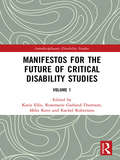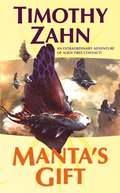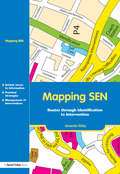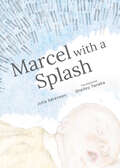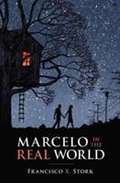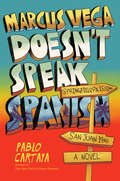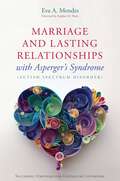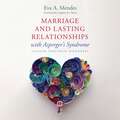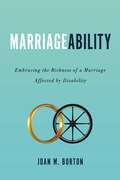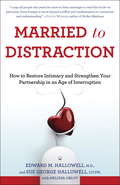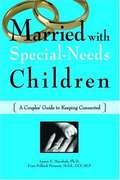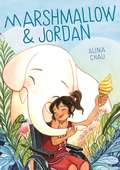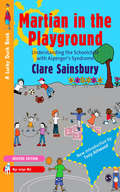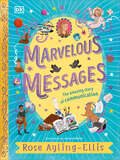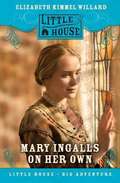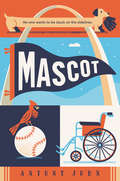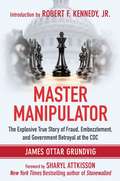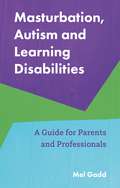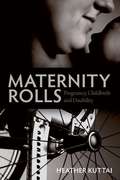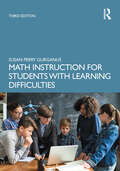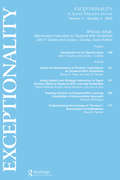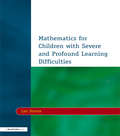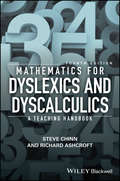- Table View
- List View
Manifestos for the Future of Critical Disability Studies: Volume 1 (Interdisciplinary Disability Studies)
by Rosemarie Garland-Thomson Rachel Robertson Katie Ellis Mike KentThis collection identifies the key tensions and conflicts being debated within the field of critical disability studies and provides both an outline of the field in its current form and offers manifestos for its future direction. Traversing a number of disciplines from science and technology studies to maternal studies, the collection offers a transdisciplinary vision for the future of critical disability studies. Some common thematic concerns emerge across the book such as digital futures, the usefulness of anger, creativity, family as disability allies, intersectionality, ethics, eugenics, accessibility and interdisciplinarity. However, the contributors who write as either disabled people or allies do not proceed from a singular approach to disability, often reflecting different or even opposing positions on these issues. Containing contributions from established and new voices in disability studies outlining their own manifesto for the future of the field, this book will be of interest to all scholars and students working within the fields of disability studies, cultural studies, sociology, law, history and education. The concerns introduced here are further explored in its sister volume Interdisciplinary approaches to disability: looking towards the future.
Manta's Gift
by Timothy ZahnI am not a fan of science fiction, but I have to admit that this is a clever, creative and well-crafted novel. My favorite review: What if James Dean were a twin-tailed manta ray swimming in Jupiter's atmosphere? Bestselling Star Wars novelist Zahn (Angelmass) gives us a tale of teen coming-of-age angst set in the herd society of the Qanska, intelligent herbivores who inhabit the equatorial band of the gas giant. Suspecting them to be non-native life, Earth's corporate masters, the Five Hundred, send in a spy to find their hidden star drive. Facing their own disaster, the Qanska agree, hoping to gain a human perspective on the impending exhaustion of their ecology. What neither side can count on is how the person injected into the Qanskan world will react. Matt Raimey, a 22-year-old paralyzed by a skiing accident, agrees to have his brain transplanted into a Qanska fetus. Given a second chance to be mobile, he also unexpectedly gets another chance to mature. Zahn concentrates more on the psychological processes at work than on the technological. Solutions to problems arise from better emotional and intellectual integrity, not simply larger databases. While the author doesn't get as deep into his characters as they do into Jupiter's depths, his portrayal of Matt/Manta is direct and involving. Qanskan life, looking much like marine reef life on Earth, is intriguingly portrayed, even if the biology of the Qanskan problem is suspect. YA readers looking for more than the usual SF action-adventure should be well pleased. (Publisher's Weekly)
Manual for the Stanford Multi Modality Imagery Test
by William L. DautermanThe author's data on the test called "The Stanford Multi-Modality Imagery Test for the Blind" as a part of a research project has been revised in this manual under the name of "The Stanford Multi-Modality Imagery Test."
Mapping SEN: Routes through Identification to Intervention
by Amanda KirbyProviding practical guidance on enhancing learning through ICT in English this book is made up of a series of projects that supplement, augment and extend the QCA ICT scheme and provide much-needed links with Units in other subjects’ schemes of work. It includes: fact cards that support each project and clearly outline its benefits in relation to teaching and learningexamples of how activities work in "real" classroomslinks to research, inspection evidence and background reading to support each projectadaptable planning examples and practical ideas provided on accompanying downloadable resources.Suitable for all trainee and practising primary teachers.
Marcel with a Splash
by Julia SørensenMarcel was born with webbed toes and an extra chromosome in this tender exploration of a child’s life with Down syndrome. When Marcel is born, the first thing the midwife notices is his webbed toes. Otherwise, he eats, he sleeps, he eats again, just like any baby. And then the doctors start to notice Marcel’s almond-shaped eyes, weak muscle tone and unusually shaped ears. They come to a conclusion: Marcel has Down syndrome. Marcel’s parents don’t know what to do with this medical terminology, so they bury it in the bottom of the garden, where it can grow in its own time and they can keep an eye on it. But Marcel doesn’t care about words yet. He grows and learns, taking to life like a fish in water. In many ways, Marcel is just like any child. He loves to laugh, be silly with his friends and go swimming during summer vacation. Marcel with a Splash goes beyond medical terms and the accompanying prejudices to discover Marcel himself. Inspired in part by her experiences as the mother of a child with Down syndrome, artist and author Julia Sørensen takes us on a poetic stroll between naps, chromosomes and tall grass, through Marcel’s beautiful, ordinary life. Key Text Features illustrations Correlates to the Common Core States Standards in English Language Arts: CCSS.ELA-LITERACY.RL.K.4 Ask and answer questions about unknown words in a text. CCSS.ELA-LITERACY.RL.K.7 With prompting and support, describe the relationship between illustrations and the story in which they appear (e.g., what moment in a story an illustration depicts). CCSS.ELA-LITERACY.RL.1.1 Ask and answer questions about key details in a text.
Marcelo in the Real World
by Francisco X. StorkThis summer, Arturo Sandoval declares, his son Marcelo will learn about the real world. He will work in the mail room of Arturo's law firm. He will interact with everyone in the office. He will be normal, as Arturo has always said he is, and not have a highly functioning form of Asperger's Syndrome, as Marcelo knows he does. And Marcelo, reluctantly, must agree to his father's terms. He soon learns reality isn't easy. Wendell, the son of Arturo's partner, offers friendship to further his own ends. The law firm hides an injustice that will transform Marcelo's world. But through it all, there is Jasmine, his beautiful and tenacious coworker, his true friend -- ...and perhaps more. <P><P> Winner of the Schneider Family Book Award
Marcus Vega Doesn't Speak Spanish
by Pablo CartayaOne boy's search for his father leads him to Puerto Rico in this moving middle grade novel, for fans of Ghost and See You in the Cosmos. <P><P>Marcus Vega is six feet tall, 180 pounds, and the owner of a premature mustache. When you look like this and you're only in the eighth grade, you're both a threat and a target. <P><P>After a fight at school leaves Marcus facing suspension, Marcus's mom decides it's time for a change of environment. She takes Marcus and his younger brother to Puerto Rico to spend a week with relatives they don't remember or have never met. <P><P>But Marcus can't focus knowing that his father--who walked out of their lives ten years ago--is somewhere on the island. <P><P>So begins Marcus's incredible journey, a series of misadventures that take him all over Puerto Rico in search of his elusive namesake. Marcus doesn't know if he'll ever find his father, but what he ultimately discovers changes his life. And he even learns a bit of Spanish along the way.
Marriage and Lasting Relationships with Asperger's Syndrome (Autism Spectrum Disorder): Successful Strategies for Couples or Counselors
by Stephen M. Shore Eva A. MendesProven counseling strategies that will help improve the relationships of married, long-term or co-habiting couples with Asperger's Syndrome (Autism Spectrum Disorder). ASD relationship expert Eva A. Mendes provides advice straight from the couples' counselling room that can be applied in day-to-day living and help with the challenges that can arise in relationships where one or both partners are on the autism spectrum. This includes issues surrounding diagnosis, mental health, sexual compatibility, sensory needs, executive functioning, theory of mind, communication, and co-parenting. She offers unique practical ideas for positive change such as creating a relationship schedule, making expression of appreciation and gratitude a part of every day, and finding mutually satisfying activities and special interests to engage in with your partner. The strategies in this book will be useful to couples themselves and any couples' counselors or therapists working with them.
Marriage and Lasting Relationships with Asperger's Syndrome (Autism Spectrum Disorder): Successful Strategies for Couples or Counselors
by Eva A. MendesProven counseling strategies that will help improve the relationships of married, long-term or co-habiting couples with Asperger's Syndrome (Autism Spectrum Disorder).ASD relationship expert Eva A. Mendes provides advice straight from the couples' counselling room that can be applied in day-to-day living and help with the challenges that can arise in relationships where one or both partners are on the autism spectrum. This includes issues surrounding diagnosis, mental health, sexual compatibility, sensory needs, executive functioning, theory of mind, communication, and co-parenting. She offers unique practical ideas for positive change such as creating a relationship schedule, making expression of appreciation and gratitude a part of every day, and finding mutually satisfying activities and special interests to engage in with your partner. The strategies in this book will be useful to couples themselves and any couples' counselors or therapists working with them.
MarriageAbility
by Joan M. BortonDisability is relentless. It affects every facet of life. <P><P> Dreams of marriage rarely include wheelchairs, walkers, or medical equipment. Yet the oneness found in a marriage with disability presents a beautiful picture of the relationship between Jesus and His Church. <P><P> This book engages the reality disability puts on the marriage relationship through the real-life, and often humorous, stories of couples living with disability. Readers will find they’re not alone in their journey. They’ll discover a framework to manage the challenges of disability and marriage. <P><P> The book will inspire those who do not live with disability to embrace those around them who do.
Married to Distraction: Restoring Intimacy and Strengthening Your Marriage in an Age of Interruption
by Edward M. Hallowell Sue George Hallowell Melissa OrlovBestselling author and attention deficit expert, Dr. Hallowell teams up with his couples' therapist wife to explain the subtle yet deadly toll a hectic lifestyle takes on intimate relationships. The author offers strategies for restoring connection and communication.
Married with Special-Needs Children: A Couples' Guide to Keeping Connected
by Laura E. Marshak Fran P. PrezantMarried with Special-Needs Children is the first book for parents to examine the stress that is often placed upon a marriage when a couple has a child with a disability. Many parents worry that even strong marriages can buckle--and some may break--under the intense demands of raising a child with special needs. In this practical, supportive guide, the authors draw on their combined professional experience in marital counseling and parent training, and feedback from hundreds of parents of children with disabilities who share their solutions and secrets for a healthy relationship.
Marshmallow & Jordan
by Alina ChauAlina Chau's Marshmallow & Jordan is a middle-grade graphic novel about a disabled, sports-loving Jordan, and the magical elephant named Marshmallow who she befriends. Jordan's days as star player for her school's basketball team ended when an accident left her paralyzed from the waist down. Now, she's still the team captain, but her competition days seem to be behind her...until an encounter with a mysterious elephant, who she names Marshmallow, helps Jordan discover a brand new sport.Will water polo be the way for Jordan to continue her athletic dreams--or will it just come between Jordan and her best friends on the basketball team? And with the big tournament right around the corner, what secret is Marshmallow hiding?
Martian in the Playground: Understanding the Schoolchild with Asperger′s Syndrome (Lucky Duck Books)
by Clare Sainsbury`This deceptively little book contains more truth and provides more insight into what it is like to have Asperger′s Syndrome than many a weighty tome on the subject. It offers a view from the inside, but it is not yet another autobiography. Admirably and refreshingly, the author has refrained from giving an account solely based on her own experiences. Instead she sets out observations from 25 different suffers, giving often astonishing and sometimes harrowing glimpses of what actually happens to a child with Asperger′s Syndrome in the classroom, in the playground, in the lunch queue and at home′ - The Journal of Child Psychology and Psychiatry This award-winning book illuminates what it means to be a person who has Aspergers Syndrome by providing a window into a unique and particular world. Drawing on her own experience of schooling, and that of a network of friends and correspondents who share her way of thinking and responding, Clare Sainsbury reminds us of the potential for harm which education holds for those who do not fit. This book holds insights that take us beyond the standard guidance on how to manage autistic spectrum disorder. It challenges the way we might handle obsessional behaviour. It invites us to celebrate the pure passion of the intellect, which such obsessions can represent, and to recognise the delight which can be experienced by children who love to collect. It reminds us that many of the autistic mannerisms we might try to suppress actually help the child to think. This revised edition includes an additional introduction and extensive summary of research in the field of Asperger′s Syndrome, both by Tony Attwood.
Marvelous Messages
by Rose Ayling-EllisJoin Rose Ayling-Ellis, her cool cat Halo, and their pigeon pal Perky on the ultimate time-traveling, globetrotting adventure to explore the story of communication as never before.Discover ancient language, decipher secret codes and special signs with Rose, Halo, and Perky on a journey through time and discover just how diverse communication can be. Rose and her interpreter Dev will be our tour guides as we explore the beginnings of language, the first hieroglyphic 'emojis' and even communication in the animal kingdom!Interspersed between the exciting episodes of Rose's journey are Messaging Milestones: fascinating timelines of fantastic innovations-including telephones, TV, printing, and the metaverse, and Rose's Superstars: a celebration of inspirational heroes, both past and present, from the deaf world—including entertainers, adventurers, inventors, sports champions and social media superstars.Cross continents, traverse time, and discover the very special gift of communication.
Mary Ingalls on Her Own
by Elizabeth Kimmel Willard(back of book)ages 8-12 MARY INGALLS lost her sight after a devastating bout of scarlet fever. Now Mary has the opportunity to attend the Iowa College for the Blind, where she will get a fresh start with her education and can learn the skills she needs for an independent future as well. It seems like a dream come true. But it also means leaving her cherished family behind in Dakota Territory, including her sister Laura. Laura's feisty personality has always complemented Mary's quiet nature, and ever since Mary lost her sight Laura has served as Mary's "eyes" to the world. Now that she's on her own, Mary must learn to get along without her beloved sister, and in the process realizes that she may have a bit of Laura's spunk in her after all. For the first time, readers will get a glimpse into the life of Mary Ingalls and will discover a whole new side of this Little House sister they've gotten to know through Laura Ingalls Wilder's classic Little House books.
Mascot
by Antony JohnThis witty, heartfelt story about perseverance in the face of adversity is perfect for fans of R. J. Palacio, Cammie McGovern, and John David Anderson.Noah Savino has been stuck in a wheelchair for months. He hates the way people treat him like he’s helpless now. He’s sick of going to physical therapy, where he isn’t making any progress. He’s tired of not having control over his own body. And he misses playing baseball—but not as much as he misses his dad, who died in the car accident that paralyzed Noah.Noah is scared he’ll never feel like his old self again. He doesn’t want people to think of him as different for the rest of his life. With the help of family and friends, he’ll have to throw off the mask he’s been hiding behind and face the fears that have kept him on the sidelines if he ever wants to move forward.
Master Manipulator: The Explosive True Story of Fraud, Embezzlement, and Government Betrayal at the CDC
by Robert F. Kennedy Jr. Sharyl Attkisson James Ottar GrundvigThe explosive true story of fraud, embezzlement, and government betrayal. In 2000, the US Centers for Disease Control (CDC) carried out a secret mission to bury, skew, and manipulate data in six vaccine safety studies, in a coordinated effort to control the message that "vaccines do not cause autism.” They did so via secret meetings and backtesting health-care data. The CDC invested tens of millions of dollars in a foreign health-care data analytics startup run by Danish scientist Poul Thorsen, a move to ensure that no link ever surfaced. But fate had other ideas. The agency soon learned it couldn’t control Thorsen. In 2011, the US Justice Department indicted him for the theft of more than $1 million of CDC grant money.Master Manipulator exposes the CDC’s hidden agenda for the cover-up. Influenced by Big Pharma money, future high-paying jobs, and political lobbyists, CDC executives charted a course different than what the findings of earlier vaccine safety studies revealed. The CDC needed an outsider to "flatten” the results of the data, while building an exit strategy: a fall guy in case the secret plan was exposed. Thorsen fit the bill nicely, conducting studies overseas. But the CDC’s plan backfired, as Thorsen took the money to the bank and the power went to his head. It would take years for his fraud scheme funneling CDC grant money to a Danish university and then back to a CDC bank account he controlled to play out.Master Manipulator is a true story of fraud and betrayal, and an insider’s view of what takes place behind the closed doors of agencies and drug companies, and with the people tasked to protect the health of American children. It’s a cautionary tale of the dangers of blind trust in the government and the health-care industry.
Masturbation, Autism and Learning Disabilities: A Guide for Parents and Professionals
by Melanie GaddIntimate self-touch and masturbation can pose many difficulties for people with learning disabilities and/or on the autistic spectrum, particularly when it happens in public settings. This frank and thorough guide looks at societal, cultural and religious views of masturbation, how teens develop into sexual beings, the right to be sexual, how to masturbate, appropriate public and private behaviour, professional responsibilities and boundaries, and legal aspects of this topic. It also contains good practice responses providing examples of the issues and solutions in action.
Maternity Rolls: Pregnancy, Childbirth and Disability
by Heather KuttaiThe author, a paraplegic, tells about her own hunt for medical advice before getting pregnant--and then about the normal births of her two children--before widening the conversation to other disabled women and sympathetic members of the medical community.
Math Instruction for Students with Learning Difficulties
by Susan Perry GurganusThis richly updated third edition of Math Instruction for Students with Learning Difficulties presents a research-based approach to mathematics instruction designed to build confidence and competence in preservice and inservice PreK- 12 teachers. Referencing benchmarks of both the National Council of Teachers of Mathematics and Common Core State Standards for Mathematics, this essential text addresses teacher and student attitudes towards mathematics as well as language issues, specific mathematics disabilities, prior experiences, and cognitive and metacognitive factors. Chapters on assessment and instruction precede strands that focus on critical concepts. Replete with suggestions for class activities and field extensions, the new edition features current research across topics and an innovative thread throughout chapters and strands: multi-tiered systems of support as they apply to mathematics instruction.
Mathematics Instruction for Students With Disabilities: A Special Issue of exceptionality
by John F. Cawley Louise J. CawleyThis special issue focuses on mathematics for students with disabilities, particularly on the topic of division. The articles discuss a number of curricula and instructional practices that have direct and meaningful implications for the classroom. They also serve as a foundation for the development of research into effective intervention practices. As a whole this issue provides an opportunity to extract selected features of instruction from the articles found herein and to contrast the effectiveness of two distinct instructional approaches--constructivism and direct/explicit instruction.
Mathematics for Children with Severe and Profound Learning Difficulties
by Les StavesThe book will covers a wide range of approaches to teaching and learning and demonstrates how mathematics can be related to personal and social development, communication and thinking skills. Written with the non-specialist in mind and including plenty of practical examples, it will make useful reading for teachers in mainstream and special schools, and learning support assistants. Early years practitioners and teachers in training may find the book useful for its descriptions of how children acquire their foundation of early mathematics and numeracy skills.
Mathematics for Dyslexics and Dyscalculics: A Teaching Handbook
by Richard Edmund Ashcroft Steve ChinnA seminal handbook in the field for more than 20 years, this new and updated edition of Mathematics for Dyslexicsand Dyscalculics contains the latest research and best practices for helping learners with numerical and mathematical difficulties. Provides a complete overview of theory and research in the fields of dyslexia and dyscalculia, along with detailed yet pragmatic methods to apply in the classroom Contains enhanced coverage of place value and the role of the decimal point, why fractions can challenge a developed logic for arithmetic, and the complexity of time along with new material on addressing anxiety, fear, motivation, and resilience in the classroom; and links to new resources including standardized tests and recommended reading lists Written by two mathematics teachers with 50 years of teaching experience between them, much of it in specialist settings for students with specific learning difficulties Offers effective teaching strategies for learners of all ages in a structured but accessible format
